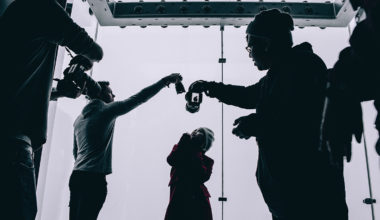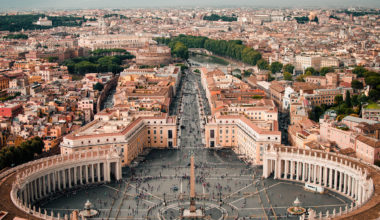On Friday, June 24, the National Press Club Journalism Institute presented a workshop on how journalists of faith navigate challenges from inside their newsrooms and from inside their faith communities. The session was supported by groups like the Gannett Foundation and my employer, the Desert Management Corporation (DMC).
Beyond my professional affiliation with the event, it struck a very personal chord with me. I respect journalists and know that our society needs them more than ever. But what I heard as I listened to their conversation is that there are ways I can support great journalism by expecting it to be truly great, even when it comes to issues of faith.
The one-hour discussion was particularly insightful because, while many of the panelists worked the religion “beat,” others covered a wide variety of topics, with their religion not making them less objective, but rather expanding their perspective and deepening their reporting.
A recurring theme from this panel—a theme that has echoed across similar conversations I have heard as part of the Faith and Media Initiative (FAMI)—was the lapse in trust that exists in all directions. Sources or spokespersons are sometimes afraid to speak out because they fear that their stories won’t be told accurately. Journalists are afraid of the controversy—or even loss of credibility—that comes from reporting on religion.
The journalists agreed that, in most instances, today’s media has fallen short on fair and comprehensive coverage of religion. Alison Bethel, VP of Corps Excellence at Report for America, was direct: “We have to do a better job at covering religion in general—in who covers it, and how. We’ve done a horrible job, which means people trust we won’t get it right.”
There was also general consensus that media need to avoid painting individuals they are reporting on with a broad brush. Aysha Khan, journalist and Harvard Divinity School student, understands this implicitly as an observant Muslim woman and reporter. She stated emphatically, “We have to be understanding of the vast diversity within religious traditions. No religion is a monolith. People don’t correspond to the shortcuts we try to take as journalists. In taking these shortcuts for years and years, we’ve trained our sources and our readers to not expect nuance.”
Richard Flory, Executive Director at USC Center for Religion and Civic Culture, echoed this idea, noting, “When you talk about religion you can talk about individuals and an individual’s faith, and you can talk about institutions. And those two don’t always line up.”
There was, to be expected, some advocacy for individual journalists, who may have separate interests and motivations than the media outlet for which they work. McKay Coppins, staff writer at The Atlantic, observed that, “…while newsrooms are by and large secular places, they also are places where most journalists are curious. They are full of curious people and people who want to learn.”
Regarding getting more than just official talking points from sources, Dawn Araujo-Hawkins, news editor at Christian Century and VP at Religion News Association, described how she now has to go the extra mile to build relationships within religious organizations and their communications departments. This includes extensive prepping for the interview, clear reinforcing of intent, and follow-ups that include reading back quotes before publication.
It was suggested that, to get a better understanding of a person’s faith and how it shows up in a news story, reporters need to dig deeper when religion enters the conversation. The conversation got both tactical and practical at this point, and follow-up was encouraged. “When people say they believe in God or that they pray, ask what they mean. How does that show up in their lives?”
This type of deeper questioning will benefit the reporting but also society’s embrace of religious diversity and pluralism. As an influential arbiter of public discourse, when media embraces and demonstrates a fuller understanding of faith, the public will eventually follow.
The discussion was framed by the recent statistic that more than 75 percent of Americans say religion is an important part of their lives. Some referenced a recent Gallup poll that reported belief in God had “dipped” to 81%, with panelists saying they were surprised—or even happy—to hear that the number was that high.
Many panelists noted that part of the problem in quantifying religious observance in America is that there is no standard definition that makes it easy to determine what precisely that means. Questions that followed from this part of the conversation included: “What are the criteria for a poll result that identifies when someone is ‘spiritual but not religious’—a familiar category when surveying religious engagement? How can a few questions in a short poll get at the complexity of faith in an individual’s life and how it impacts their work life, their political positions, their decision-making process?”
Moderator Julie Moos, Executive Director of NPCJI asked toward the end of the discussion, “Who is religion journalism for?”
Araujo-Hawkins stated simply, “Religion journalism is for everyone.” She then expanded the idea to describe coverage of faith as, maybe, part of bridging some of what divides us. “What you learn about your neighbors and the world is so deep and fruitful.”
“Religion is always in the room,” said Holly Meyer, religion news editor at The Associated Press. She acknowledged the challenges of covering religions but offered advice. “It makes people uncomfortable. Don’t look away. Don’t ignore it. Be curious and empathetic.”
Good advice for the journalist, and wise counsel for all of us looking to build bridges of understanding across the roaring rivers of distrust in today’s society.
Special thanks to the National Press Club Journalism Institute for making conversations like this possible.
References or useful resources that came up during the conversation:
Religions News Association
The Varieties of American Evangelicalism—USC Center for Religion and Civic Culture
Religion and Public Life—Harvard Divinity School
Inclusive Storytelling—new from the AP Style Book


